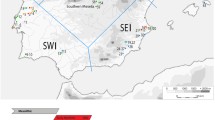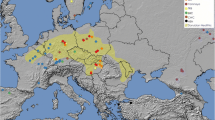Abstract
Genetic studies of Neolithic groups in central Europe have provided insights into the demographic processes that have occurred during the initial transition to agriculture as well as in later Neolithic contexts. While distinct genetic patterns between indigenous hunter-gatherers and Neolithic farmers in Europe have been observed, it is still under discussion how the genetic diversity changed during the 5,000-year span of the Neolithic period. In order to investigate genetic patterns after the earliest farming communities, we carried out an ancient mitochondrial DNA (mtDNA) analysis of 34 individuals from Wittmar, Germany representing three different Neolithic farming groups (ca. 5,200–4,300 cal bc) including Rössen societies. Ancient DNA analysis was successful for six individuals associated with the Middle Neolithic Rössen and observed haplotypes were assigned to mtDNA haplogroups H5, HV0, U5, and K. Our results offer perspectives on the genetic composition of individuals associated with the Rössen culture at Wittmar and permit insights into genetic landscapes in central Europe at a time when regional groups first emerged during the Middle Neolithic.


Similar content being viewed by others

References
Achilli A, Rengo C, Magri C, Battaglia V, Olivieri A, Scozzari R, Cruciani F, Zeviani M, Briem E, Carelli V, Moral P, Dugoujon JM, Roostalu U, Loogvali EL, Kivisild T, Bandelt HJ, Richards M, Villems R, Santachiara-Benerecetti AS, Semino O, Torroni A (2004) The molecular dissection of mtDNA haplogroup H confirms that the Franco-Cantabrian glacial refuge was a major source for the European gene pool. Am J Hum Genet 75(5):910–918. doi:10.1086/425590
Andrews RM, Kubacka I, Chinnery PF, Lightowlers RN, Turnbull DM, Howell N (1999) Reanalysis and revision of the Cambridge reference sequence for human mitochondrial DNA. Nat Genet 23(2):147. doi:10.1038/13779
Bollongino R, Nehlich O, Richards MP, Orschiedt J, Thomas MG, Sell C, Fajkosova Z, Powell A, Burger J (2013) 2000 years of parallel societies in Stone Age Central Europe. Science 342(6157):479–481. doi:10.1126/science.1245049
Bramanti B, Thomas MG, Haak W, Unterlaender M, Jores P, Tambets K, Antanaitis-Jacobs I, Haidle MN, Jankauskas R, Kind CJ, Lueth F, Terberger T, Hiller J, Matsumura S, Forster P, Burger J (2009) Genetic discontinuity between local hunter-gatherers and central Europe's first farmers. Science 326(5949):137–140. doi:10.1126/science.1176869
Brandt G, Haak W, Adler CJ, Roth C, Szecsenyi-Nagy A, Karimnia S, Moller-Rieker S, Meller H, Ganslmeier R, Friederich S, Dresely V, Nicklisch N, Pickrell JK, Sirocko F, Reich D, Cooper A, Alt KW (2013) Ancient DNA reveals key stages in the formation of central European mitochondrial genetic diversity. Science 342(6155):257–261. doi:10.1126/science.1241844
Brotherton P, Haak W, Templeton J, Brandt G, Soubrier J, Jane Adler C, Richards SM, Sarkissian CD, Ganslmeier R, Friederich S, Dresely V, van Oven M, Kenyon R, Van der Hoek MB, Korlach J, Luong K, Ho SY, Quintana-Murci L, Behar DM, Meller H, Alt KW, Cooper A, Adhikarla S, Ganesh Prasad AK, Pitchappan R, Varatharajan Santhakumari A, Balanovska E, Balanovsky O, Bertranpetit J, Comas D, Martinez-Cruz B, Mele M, Clarke AC, Matisoo-Smith EA, Dulik MC, Gaieski JB, Owings AC, Schurr TG, Vilar MG, Hobbs A, Soodyall H, Javed A, Parida L, Platt DE, Royyuru AK, Jin L, Li S, Kaplan ME, Merchant NC, John Mitchell R, Renfrew C, Lacerda DR, Santos FR, Soria Hernanz DF, Spencer Wells R, Swamikrishnan P, Tyler-Smith C, Paulo Vieira P, Ziegle JS (2013) Neolithic mitochondrial haplogroup H genomes and the genetic origins of Europeans. Nat Commun 4:1764. doi:10.1038/ncomms2656
Dolukhanov P, Shukurov A, Gronenborn D, Sokoloff D, Timofeev V, Zaitseva G (2005) The chronology of Neolithic dispersal in Central and Eastern Europe. J Archaeol Sci 32(10):1441–1458. doi:10.1016/j.jas.2005.03.021
Fischer U (1956) Die Gräber der Steinzeit im Saalegebiet: Studien über neolithische und frühbronzezeitliche Grab- und Bestattungsformen in Sachsen-Thüringen. Walter de Gruyter, Berlin
Galeta P, Sladek V, Sosna D, Bruzek J (2011) Modeling neolithic dispersal in Central Europe: demographic implications. Am J Phys Anthropol 146:104–115. doi:10.1002/ajpa.21572
Gamba C, Fernández E, Tirado M, Deguilloux MF, Pemonge MH, Utrilla P, Edo M, Molist M, Rasteiro R, Chikhi L, Arroyo-Pardo E (2012) Ancient DNA from an Early Neolithic Iberian population supports a pioneer colonization by first farmers. Mol Ecol 21(1):45–56. doi:10.1111/j.1365-294X.2011.05361.x
Gronenborn D (1999) A variation on a basic theme: the transition to farming in Southern Central Europe. J World Prehis 13(2):123–210
Gronenborn D (2007) Beyond the models: ‘neolithisation’ in Central Europe. In: Whittle A, Cummings V (eds) Going over: the Mesolithic-Neolithic transition in north-west Europe. Proceedings of the British Academy, Oxford, pp 73–98
Guilaine J (2007) Die Ausbreitung der neolithischen Lebensweise im Mittelmeerraum. In: Lichter C, Gün S (eds) Vor 12.000 Jahren in Anatolien: Die ältesten Monumente der Menschheit. Theiss, Stuttgart, pp 166–176
Haak W, Forster P, Bramanti B, Matsumura S, Brandt G, Tanzer M, Villems R, Renfrew C, Gronenborn D, Alt KW, Burger J (2005) Ancient DNA from the first European farmers in 7500-year-old Neolithic sites. Science 310(5750):1016–1018. doi:10.1126/science.1118725
Haak W, Balanovsky O, Sanchez JJ, Koshel S, Zaporozhchenko V, Adler CJ, Der Sarkissian CS, Brandt G, Schwarz C, Nicklisch N, Dresely V, Fritsch B, Balanovska E, Villems R, Meller H, Alt KW, Cooper A (2010) Ancient DNA from European early Neolithic farmers reveals their Near Eastern affinities. PLoS Biol 8(11):e1000536. doi:10.1371/journal.pbio.1000536
Häusler A (1971) Die Bestattungssitten des Früh- und Mittelneolithikums und ihre Interpretation. In: Schlette F (ed) Evolution und Revolution im Alten Orient und in Europa: das Neolithikum als historische Erscheinung. Akademie-Verlag, Berlin, pp 101–119
Häusler A (1994) Grab- und Bestattungssitten des Neolithikums und der frühen Bronzezeit in Mitteleuropa. Zeitschrift für Archäologie 28:23–61
Kampffmeyer U (1991) Die Keramik der Siedlung Hüde I am Dümmer. Untersuchungen zur Neolithisierung des nordwestlichen Flachlandes., vol 2-3. Untersuchungen zur Neolithisierung des nordwestlichen Flachlandes. Georg-August-Universität Göttingen, Göttingen
Lacan M, Keyser C, Ricaut FX, Brucato N, Duranthon F, Guilaine J, Crubezy E, Ludes B (2011a) Ancient DNA reveals male diffusion through the Neolithic Mediterranean route. Proc Natl Acad Sci U S A 108(24):9788–9791. doi:10.1073/pnas.1100723108
Lacan M, Keyser C, Ricaut FX, Brucato N, Tarrus J, Bosch A, Guilaine J, Crubezy E, Ludes B (2011b) Ancient DNA suggests the leading role played by men in the Neolithic dissemination. Proc Natl Acad Sci U S A 108(45):18255–18259. doi:10.1073/pnas.1113061108
Lacan M, Keyser C, Crubezy E, Ludes B (2012) Ancestry of modern Europeans: contributions of ancient DNA. Cell Mol Life Sci. doi:10.1007/s00018-012-1180-5
Lee EJ, Makarewicz C, Renneberg R, Harder M, Krause-Kyora B, Müller S, Ostritz S, Fehren-Schmitz L, Schreiber S, Müller J, von Wurmb-Schwark N, Nebel A (2012a) Emerging genetic patterns of the European Neolithic: perspectives from a late Neolithic Bell Beaker burial site in Germany. Am J Phys Anthropol 148(4):571–579. doi:10.1002/ajpa.22074
Lee EJ, Renneberg R, Harder M, Krause-Kyora B, Rinne C, Müller J, Nebel A, von Wurmb-Schwark N (2012b) Collective burials among agro-pastoral societies in later Neolithic Germany: perspectives from ancient DNA. J Archaeol Sci. doi:10.1016/j.jas.2012.08.037
Lüning J (1991) Frühe Bauern in Mitteleuropa im 6. und 5. Jahrtausend v. Chr. Jahrbuch des Römisch-Germanischen Zentralmuseums Mainz 35:27–93
Lüning J (2000) Steinzeitliche Bauern in Deutschland. Die Landwirtschaft im Neolithikum. Universitätsforschungen zur Prähistorischen Archäologie 58. Habelt, Bonn
Malmström H, Gilbert MT, Thomas MG, Brandstrom M, Storå J, Molnar P, Andersen PK, Bendixen C, Holmlund G, Götherström A, Willerslev E (2009) Ancient DNA reveals lack of continuity between Neolithic hunter-gatherers and contemporary Scandinavians. Curr Biol 19(20):1758–1762. doi:10.1016/j.cub.2009.09.017
Müller J (2009) Die Jungsteinzeit (6000-2000 v. Chr.). In: von Schnurbein S (ed) Atlas der Vorgeschichte. Europa von den ersten Menschen bis Christi Geburt. Theiss, Stuttgart, pp 60–107
Müller J (2011) Early pottery in the North—a southern perspective. In: Hartz S, Lüth F, Terberger T (eds) Early pottery in the baltic—dating, origin and social context. International Workshop at Schleswig from 20th to 21st October 2006, vol 89. Bericht der Römisch-Germanischen Kommission, Frankfurt a. M., pp 287–301
Pereira L, Richards M, Goios A, Alonso A, Albarrán C, Garcia O, Behar DM, Golge M, Hatina J, Al-Gazali L, Bradley DG, Macaulay V, Amorim A (2005) High-resolution mtDNA evidence for the late-glacial resettlement of Europe from an Iberian refugium. Genome Res 15(1):19–24. doi:10.1101/gr.3182305
Preuß J (ed) (1998) Das Neolithikum in Mitteleuropa. Kulturen-Wirtschaft-Umwelt vom 6. bis 2. Jahrtausend v.u.Z., Band 3. Beier und Beran, Weissbach
Price TD (2001) Europe's first farmers. Cambridge University Press, Cambridge
Raemaekers DCM (1999) The articulation of a ‘New Neolithic’. The meaning of the Swifterbant culture for the process of Neolithisation in the western part of the North European Plain, vol 3. Archaeological Series Leiden University, Leiden University, Leiden
Rötting H (1983) Das alt- und mittelneolithische Gräberfeld von Wittmar, Ldkr. Wolfenbüttel. Eine Übersicht zu den Grabungsergebnissen. In: Wegner G (ed) Frühe Bauernkulturen in Niedersachsen. Linienbandkeramik, Stichbandkeramik, Rössener Kultur. Archäologische Mitteilungen aus Nordwestdeutschland Beiheft 1. Staatliches Museum für Naturkunde und Vorgeschichte, Oldenburg, pp 135–157
Rötting H (1985) Der älteste Totenplatz in Niedersachsen. In: Wilhelmi K (ed) Ausgrabungen in Niedersachsen Archäologische Denkmalpflege 1979-1984. Theiss, Stuttgart, pp 103–108
Shennan S (2009) Evolutionary demography and the population history of the European Early Neolithic. Human Biology 81(2–3):339–355
Spatz H (1996) Beiträge zum Kulturenkomplex Hinkelstein - Großgartach - Rössen: der keramische Fundstoff des Mittelneolithikums aus dem mittleren Neckarland und seine zeitliche Gliederung, vol 37. Materialhefte zur Vor- und Frühgeschichte in Baden-Württemberg, Stuttgart
Torroni A, Bandelt HJ, D'Urbano L, Lahermo P, Moral P, Sellitto D, Rengo C, Forster P, Savontaus ML, Bonne-Tamir B, Scozzari R (1998) mtDNA analysis reveals a major late Paleolithic population expansion from southwestern to northeastern Europe. Am J Hum Genet 62(5):1137–1152. doi:10.1086/301822
Torroni A, Bandelt HJ, Macaulay V, Richards M, Cruciani F, Rengo C, Martinez-Cabrera V, Villems R, Kivisild T, Metspalu E, Parik J, Tolk HV, Tambets K, Forster P, Karger B, Francalacci P, Rudan P, Janicijevic B, Rickards O, Savontaus ML, Huoponen K, Laitinen V, Koivumaki S, Sykes B, Hickey E, Novelletto A, Moral P, Sellitto D, Coppa A, Al-Zaheri N, Santachiara-Benerecetti AS, Semino O, Scozzari R (2001) A signal, from human mtDNA, of postglacial recolonization in Europe. Am J Hum Genet 69(4):844–852. doi:10.1086/323485
Whittle A, Cummings V (eds) (2007) Going over: the Mesolithic-Neolithic transition in North-West Europe. Proceedings of the British Academy, Oxford
Acknowledgments
This study was supported by the Graduate School “Human Development in Landscapes” at Kiel University and the Deutsche Forschungsgemeinschaft (DFG) under the Priority Program 1400 “Early monumentality and social differentiation: on the origin and development of Neolithic large-scale buildings and the emergence of early complex societies in Northern Central Europe” (Project No. RE 3001/1-1). We thank Wolf-Dieter Steinmetz (Braunschweigisches Landesmuseum) for handling of the skeletal materials. The authors also thank Ines Reese and Holger Dietrich for their assistance with the figures.
Author information
Authors and Affiliations
Corresponding author
Additional information
Esther J. Lee and Ben Krause-Kyora shared first authorship
Rights and permissions
About this article
Cite this article
Lee, E.J., Krause-Kyora, B., Rinne, C. et al. Ancient DNA insights from the Middle Neolithic in Germany. Archaeol Anthropol Sci 6, 199–204 (2014). https://doi.org/10.1007/s12520-013-0173-0
Received:
Accepted:
Published:
Issue Date:
DOI: https://doi.org/10.1007/s12520-013-0173-0



